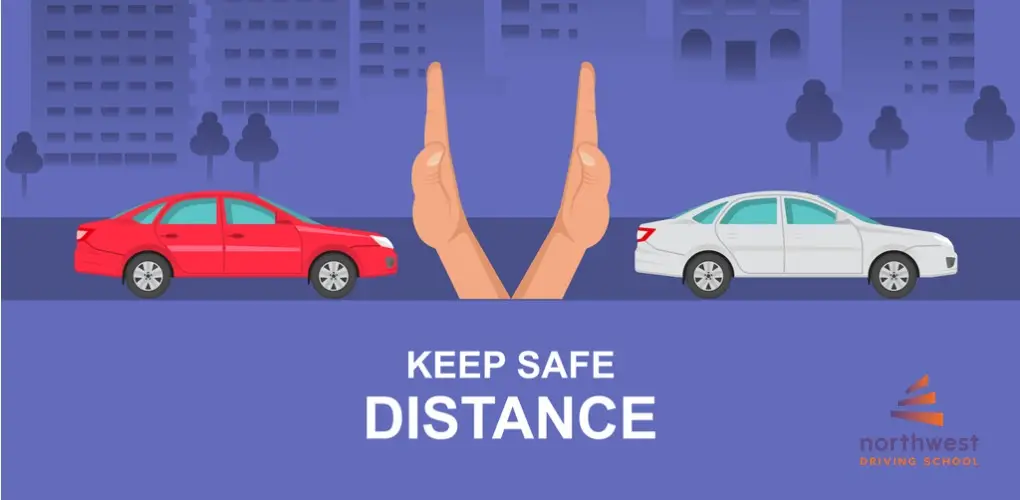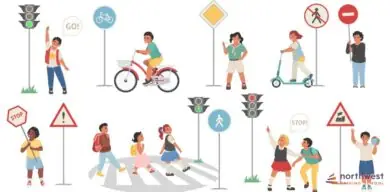- Traffic School
What Factors Affect Stopping Distance?

Have you ever noticed the phrase “stop time” when it comes to your car? It’s an important concept often overlooked by drivers but can seriously impact your safety and even your life.
Knowing the expected stopping distance of your vehicle could help save you from a head-on collision or other uncontrolled braking scenarios.
In this blog post, we’ll cover how to calculate the stopping distance of your car in order to maximize safety on the roads and stay safe behind the wheel. We’ll also examine why it’s important to know what minimum stopping distance you should expect from each factor.
Finally, we’ll provide some tips for reducing halting distances while driving. Ready to learn about this crucial safety factor? Read on!
Read More: Do You Know the Stopping Distance of Your Car?
Table of Contents
- Understanding The Physics Of Stopping Distance – Learning What Impacts The Stopping Distance Of Your Car
- Check Your Brakes Regularly – How To Inspect And Take Care Of Your Brakes For Maximum Safety
- Consider Different Weather Conditions – Rain, Snow, And Other Weather Impacts Your Car’s Stopping Distance
- Knowing When To Replace Tires – How Often You Should Replace Your Tires And Why It Matters
- Improve Your Driving Skills – Tips And Tricks To Reduce Stopping Distances When Necessary
- Take Advantage Of Safety Features – Benefits Of Anti-lock Brakes, Collision Avoidance Systems, And Traction Control Systems
- Keeping You And Your Passengers Safe
Understanding The Physics Of Stopping Distance – Learning What Impacts The Stopping Distance Of Your Car
As a driver, understanding the physics of stopping distance is crucial to ensuring your safety on the road. It’s not just about slamming on the brakes at the last minute but also taking into account the many factors that can influence your car’s stopping distance.
These factors include your car’s weight, tire traction, road conditions, and your own reaction time. By learning about these variables and how they interact, you can make smarter decisions while driving and avoid potential accidents.
Check Your Brakes Regularly – How To Inspect And Take Care Of Your Brakes For Maximum Safety
Your safety on the road should be a top priority. One way to ensure that you are safe when on the road is by regularly checking your brakes. Brakes are crucial in stopping your vehicle, so inspecting them regularly is important.
To start off, look for signs of wear and tear, such as unusual noises, vibrations, or a soft brake pedal. If you notice any of these signs, take your vehicle to an expert mechanic. They will be able to diagnose the problem and fix it.
Additionally, make sure to keep your brake fluid at the recommended levels and replace it every few years. Taking care of your brakes ensures a smooth and safe ride every time you hit the road.
Consider Different Weather Conditions – Rain, Snow, And Other Weather Impacts Your Car’s Stopping Distance
Driving in hazardous weather conditions can be a nerve-wracking experience. The rain pelting against your windshield, the snowflakes slowly accumulating on your hood – these weather conditions significantly impact your car’s stopping distance.
In fact, it can take up to twice the distance to stop your vehicle on a wet road and up to ten times the distance on a snowy or icy surface.
Practicing safe driving habits and maintaining a safe driving distance from other vehicles when dealing with hazardous weather is essential. Remember, safety should always be your top priority on the roads.
Read More: Bad Weather Driving Tips
Knowing When To Replace Tires – How Often You Should Replace Your Tires And Why It Matters
Your tires are the only part of your vehicle that touches the road, so it’s important to ensure they’re in good shape. But how do you know when to replace them?
Many experts recommend replacing your tires every 6 years or 45,000 miles, whichever comes first. However, the frequency of replacement can vary depending on driving habits and weather conditions.
It’s important to keep an eye out for signs of wear and tear, such as cracks in the sidewall or uneven tread wear. Replacing your tires regularly can improve your vehicle’s safety and performance, so don’t neglect this crucial aspect of car maintenance.
Improve Your Driving Skills – Tips And Tricks To Reduce Stopping Distances When Necessary
Driving is an essential skill that requires constant attention and focus on the road. However, unforeseen circumstances may arise, forcing us to reduce stopping distances immediately.
To improve your driving skills, there are tips and tricks that you can employ to combat this issue. For instance, maintaining a safe following distance behind other vehicles reduces the risk of sudden stops.
Additionally, staying alert and avoiding distractions such as phone calls, text messages, or loud music will enable you to react quickly to any situation that may arise on the road.
As you sharpen your skills on the road, you’ll reduce stopping distances and increase your safety while driving.
Take Advantage Of Safety Features – Benefits Of Anti-lock Brakes, Collision Avoidance Systems, And Traction Control Systems
When it comes to vehicles, safety should always be a top priority. Luckily, modern technology has given us some amazing safety features to take advantage of. One of the most important of these is anti-lock brakes, which keep your wheels from locking up and skidding when you hit the brakes hard.
Another vital safety feature is collision avoidance systems, which use sensors to alert you when you’re getting too close to another vehicle and may even apply the brakes for you in an emergency. Finally, traction control systems help your wheels grip the road better in slippery conditions, reducing the risk of sliding or spinning out.
Using these safety features, you can help keep yourself and your passengers safer on the road, regardless of weather or driving conditions.
Keeping You And Your Passengers Safe
Understanding your vehicle’s stopping distance is necessary to stay safe on the road. You need to know the physics behind it and how different variables can alter it. It’s important to regularly inspect and take care of your brakes and consider various weather conditions before you drive.
Knowing when to replace your tires is essential, and improving your driving skills will help greatly, too. There are even safety features available on some cars that you can use for accelerated stopping distances under certain circumstances.
If you’re looking to take the dive and learn to stay safe on the road, contact Northwest Driving School today. We offer a variety of lessons and resources to keep you safe, no matter the road conditions. Drive safe!
At Northwest, you can expect outstanding classes on campus and behind the wheel that are engaging, fact-filled, entertaining, and geared toward success.



